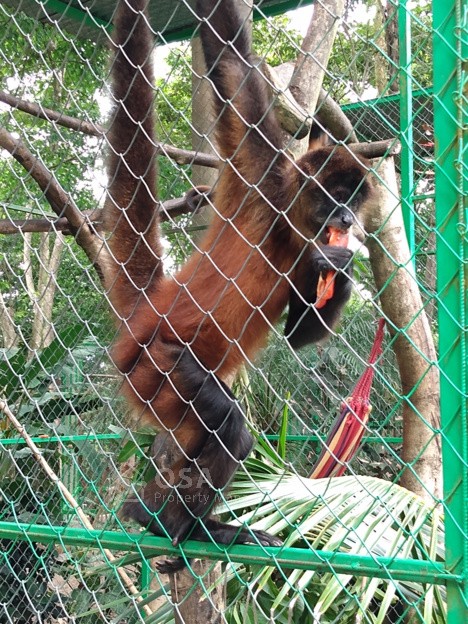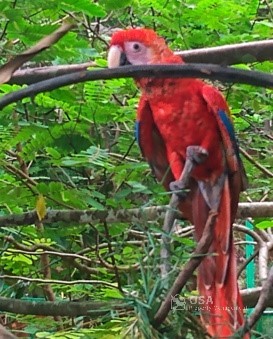Earlier this week, we decided to take a Alturas Wildlife Sanctuary Tour, located just a few kilometers north of Uvita right off  Highway 34. The sanctuary is a rescue and rehabilitation center for sick, injured and orphaned wildlife. While the sanctuary tries to release the animals back into wild; there are many animals that are unable to go back into the wild, so they become permanent residents of the sanctuary.
Highway 34. The sanctuary is a rescue and rehabilitation center for sick, injured and orphaned wildlife. While the sanctuary tries to release the animals back into wild; there are many animals that are unable to go back into the wild, so they become permanent residents of the sanctuary.
The sanctuary was originally started up in the mountains above the town of Cortes, which is the town just seven minutes south of our house; however, the sanctuary was not able to continue at that location due to several logistical issues. However, an owner of a hotel had extra land and buildings and inquired on what he could do to help the sanctuary. So in 2014 the sanctuary was moved to it’s current location between Dominical and Uvita.
The sanctuary will take in any non-domestic animal. There are five main reasons animals end up at the sanctuary:
- Animals that have been electrocuted by the power lines
- Animals who have been hurt on the highway
- Animals who have been orphaned by the parents due to sickness/deformity
- Animals who were unintentionally orphaned by people who didn’t realize the parents were around (hence the need for more education)
- Animals that have been previous ‘domestic’ pets.
Alturas Wildlife Sanctuary Tour Information
Typically tours are 15 people. When we signed up it was just the two us, but by the time we arrived, the tour had 17 people. The guide was extremely knowledgeable and spoke great English. We weren’t allowed to go into the vet center, as they don’t want any diseases to be transferred or to bother the sick animals. There was also the rehabilitation location and the baby housing, which we couldn’t go see. We were only able to see the animals who permanently live in the sanctuary. These are typically animals who have been pets and now don’t know how to live in the wild or they have disabilities and wouldn’t be able to survive in the wild.
The tour cost: $25/adult ($32 if you want lunch), $15/kids (ages 3-12)
Below are some pictures of the animals we saw:
 White faced capuchin monkey
White faced capuchin monkey Photo below of sloths: 3 year old sloths–actually 2 there hugging each other. When sloths in captivity when they are little, they are given stuffed animals to hug, but because they were put together they hug each other all the time.

3 year old sloths–actually 2 there hugging each other.
 Aracari Toucan
Aracari Toucan Photo below: Spider monkeys (these two were about 75 years old, which is extremely old for them–so they don’t move around munch)

Spider monkey
Photo below: The Amazon Parrot lived in a hotel for 35+ years and doesn’t know that it can actually fly. There is nothing wrong with its wings and is kept in an open area, but it never flies away.

Amazon Parrot who lived in a hotel for 35+ years.
Below: Baby Scarlet Macaw who couldn’t fly due to wing issue and does not eating the natural food, so can’t go back into the wild.

Scarlet macaw (locals call them lapas)
Below is a photo of a Peccary – not related to the wild hog or any pig even though it has a snout like a pig—male was very ‘angry’.
Photo below: Scarlet Macaw mate for life and like a real live love story, one of the birds couldn’t go back in the wild so the other one stays at the sanctuary, even though it can fly away.

Okay this was a white frog that was just on the side of the hotel building wall…not really in the sanctuary, right by here there  was a pond that had a large koi fish and at least 5 small baby turtles.
was a pond that had a large koi fish and at least 5 small baby turtles.
Nocturnal and Other Animals
There were a few nocturnal animals that we weren’t able to see; hence no pictures. Those were a porcupine, kinkajou (also called honey bear; small and related to raccoon) and There was also a small American crocodile, but it was hiding in the water as it had just arrived a couple days ago, so couldn’t get a clear picture. We did see two squirrels, but we’ve all seen those so I didn’t take a picture! LOL.
Panama Owl Monkey
This animal is native to Panama, but it was illegally brought into Costa Rica over the boarder in a back pack when it was just a baby. Costa Rica was unable to get Panama to respond on how to get it back to them and into the wild there; so now it must stay by itself at the sanctuary since it’s not native and also wouldn’t know how to live in the wild now after so long. So sad really, since they are very social animals that typically roam in groups of 15+ – so sad for this guy!
Hotel Villas Alturas
I love animals, but besides the animals, the views at this hotel were AMAZING. You’ll be able to see the whale’s tail down on the shore (well hopefully you can see it!).
Tips about Alturas Wildlife Sanctuary Tour
A few things to note if you’re going to visit: you can eat lunch there, but we didn’t so can’t provide any feedback on that. The volunteers were working towards the end of our tour (approx. 2PM) and it was slightly distracting and annoying as they were loud so it was hard to hear the guide. Not sure when they do the volunteer work (i.e. feed, water, clean the animals), but beware!!!
They do provide umbrellas, as you know it can rain at anytime in Costa Rica! However, they do not provide any insect repellent and there are lots of bugs that bite, so take some with you!
The path to the enclosures is a rock path which is steep both up and down, so ensure you’re able to walk if you book the Alturas Wildlife Sanctuary tour.
Volunteer Opportunities
They are always looking for volunteers to help out. In fact, several times volunteering was mentioned, but it was for a full week or, even months at a time. The reason for this is that there is quite a bit of training needed. I did inquire if a local could volunteer and it sounds promising(!), so I’m going to check into that. How amazing would it be to be around these animals once a week! Fingers crossed!
Comparing Alturas Wildlife Sanctuary Tour
This is the second wildlife sanctuary we have visited while in Costa Rica. The other one was the Toucan Sanctuary and Reserve in San Jose. While we liked the Toucan Sanctuary/Reserve in San Jose, we liked this one slightly better. The main reason we like the Alturas Wildlife Sanctuary Tour a bit better was because it was more in the jungle and the animals’ typical habitat. The Toucan one was in the middle of a residential neighborhood, which didn’t have quite the same feel. However, both tours are well worth visiting and the entry fee is donated to the reserves to help these animals, which is the best part!
Contact Us for more information about this tour or other services
Amy & Jason | CRLiving@osapropertymanagement.com

